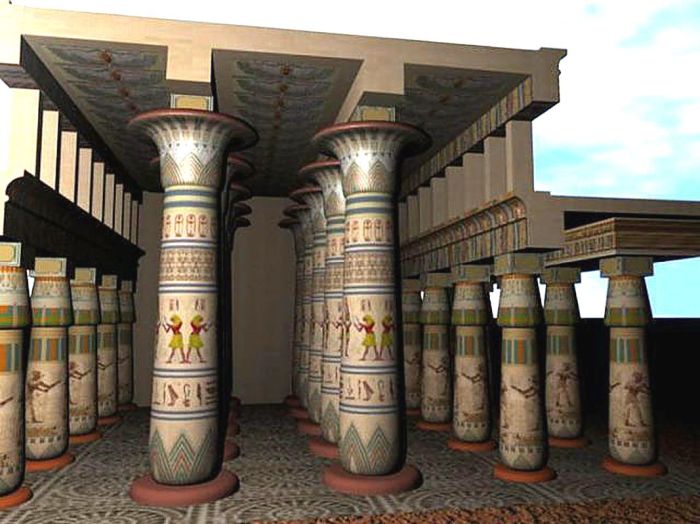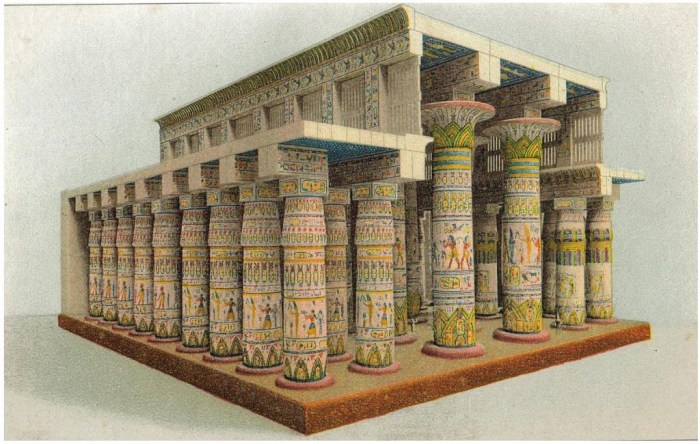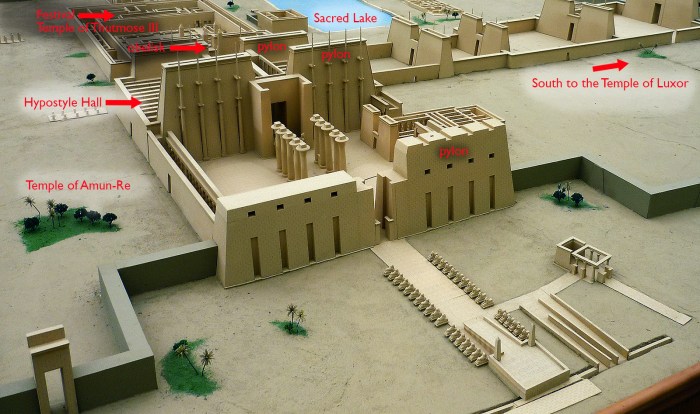Temple of amun re and hypostyle hall ap art history – The Temple of Amun-Re and Hypostyle Hall, renowned for their architectural splendor and historical significance, stand as testaments to the ingenuity and artistry of ancient Egypt. This exploration delves into the temple’s historical origins, architectural design, religious importance, and artistic legacy, offering a comprehensive understanding of its enduring impact on Egyptian civilization and beyond.
Temple of Amun-Re
The Temple of Amun-Re at Karnak, Egypt, stands as one of the most awe-inspiring and significant religious structures in ancient history. Built over centuries by successive pharaohs, the temple served as the central cult center for the worship of the god Amun-Re, the patron deity of Thebes.
Architectural Design and Construction
- The temple complex covers an area of over 200 acres, featuring numerous courtyards, chapels, and pylons.
- The main temple is composed of a series of hypostyle halls, each supported by massive columns adorned with intricate reliefs and inscriptions.
- The sanctuary, located at the heart of the temple, housed the sacred barque of Amun-Re, which was carried in processions during religious festivals.
Religious and Cultural Importance
- The Temple of Amun-Re was the spiritual center of ancient Thebes and played a pivotal role in Egyptian religious life.
- The pharaohs were considered to be the earthly representatives of Amun-Re and conducted elaborate rituals and ceremonies within the temple.
- The temple also served as a repository for sacred texts, artifacts, and treasures, representing the wealth and power of the ancient Egyptian civilization.
- The hall measures approximately 170 meters long and 103 meters wide, with a ceiling height of over 20 meters.
- It is supported by 134 massive papyrus columns, arranged in 16 rows.
- The columns are adorned with intricate carvings depicting scenes of religious rituals, military campaigns, and daily life.
- The Hypostyle Hall served as a vast assembly space for religious ceremonies and festivals.
- It was also used for the storage of sacred objects and as a meeting place for priests and officials.
- The reliefs and inscriptions on the columns provided a visual narrative of Egyptian history and religious beliefs.
- The papyrus columns represent the marshes of the Nile Delta, symbolizing the origins of life and fertility.
- The reliefs depict the pharaohs making offerings to Amun-Re, emphasizing their divine authority.
- The scenes of everyday life provide a glimpse into the social and cultural aspects of ancient Egyptian society.
- The temple complex incorporates elements from various architectural periods, showcasing the evolution of Egyptian temple design.
- The monumental pylons and massive columns are characteristic of the New Kingdom period.
- The hypostyle halls, with their rows of papyrus columns, became a defining feature of later Egyptian temples.
- The design of the Temple of Amun-Re influenced subsequent Egyptian temple architecture, including the temples at Luxor and Edfu.
- The use of colossal statues and reliefs set a precedent for monumental art in later civilizations.
- The architectural principles employed in the temple have been studied and admired by architects and historians for centuries.
- The reliefs and inscriptions were carved into the stone using chisels and hammers.
- The colors were applied using pigments made from natural materials such as minerals and plants.
- The artists employed a variety of techniques to create depth, perspective, and movement in the reliefs.
- Archaeological excavations have uncovered significant portions of the temple complex, providing insights into its history and construction.
- Restoration efforts have focused on preserving the remaining structures and protecting them from further deterioration.
- The ongoing work ensures that the temple remains a valuable historical and cultural resource for future generations.
- Tourism has increased awareness of the temple’s importance but also poses challenges in terms of preservation and management.
- Modern interpretations of the temple’s symbolism and iconography have sparked debates about the nature of ancient Egyptian religion and society.
- The temple continues to be a site of pilgrimage and spiritual reflection for people from around the world.
- Preserving the temple from environmental factors, tourism, and urbanization requires ongoing efforts and funding.
- Managing the balance between accessibility and conservation is a delicate task.
- Collaboration between archaeologists, conservators, and tourism authorities is essential to ensure the temple’s long-term preservation and appreciation.
Hypostyle Hall

The Hypostyle Hall within the Temple of Amun-Re is a marvel of ancient architecture and one of the most iconic spaces in Egyptian history.
Architectural Features and Dimensions
Purpose and Function
Symbolism and Iconography
Art Historical Context

The Temple of Amun-Re and its Hypostyle Hall are significant examples of ancient Egyptian architecture, reflecting the advanced skills and artistic vision of the civilization.
Architectural Styles
Influence on Subsequent Developments
Artistic Techniques and Materials, Temple of amun re and hypostyle hall ap art history
Modern Reception and Interpretation

The Temple of Amun-Re has been a source of fascination and inspiration for centuries, and its significance continues to be explored and debated.
Archaeological Excavations and Restoration Efforts
Impact of Tourism and Modern Interpretations
Challenges and Opportunities in Preservation and Management
Popular Questions: Temple Of Amun Re And Hypostyle Hall Ap Art History
What is the historical significance of the Temple of Amun-Re?
The Temple of Amun-Re was the central religious complex of the ancient Egyptian city of Karnak, dedicated to the worship of the god Amun-Re, the patron deity of Thebes.
What are the architectural features of the Hypostyle Hall?
The Hypostyle Hall is a vast, columned hall within the Temple of Amun-Re, renowned for its towering pillars, intricate reliefs, and painted ceilings.
How did the temple’s design influence subsequent architectural developments?
The architectural style of the Temple of Amun-Re and Hypostyle Hall influenced the design of numerous subsequent temples and palaces in ancient Egypt and beyond, becoming a hallmark of Egyptian architecture.